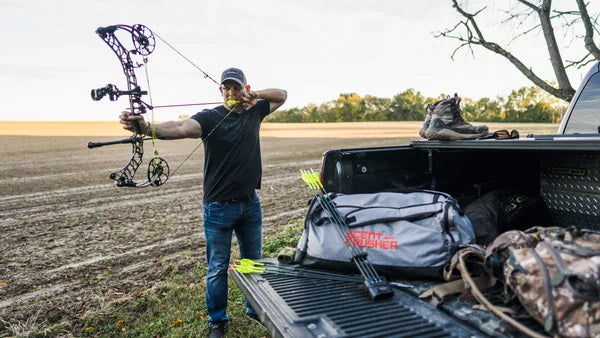
Venison is a versatile wild game that can be used in countless recipes. You can use venison for burgers and pasta dishes or add it to casseroles and tacos. Turn your deer harvest into a hearty meal for you or your family and take the deer from field to table. Review our tips for field dressing your deer, processing the meat and turning it into a delicious, protein-filled meal.
Field Dressing
After you’ve made a successful shot and given the deer enough time to pass, the next thing you should do is field dress the deer. Field dressing the deer means removing the internal organs. This will help keep the meat cool, which will help prevent bacteria growth.
Use a sharp knife with a long blade, over four inches, to cut the deer open from pelvis to jawbone and remove the internal organs one-by-one. Review the guidelines on the Hunter Ed website for detailed instructions.
It’s possible that the broadhead is still in the deer. If you didn’t recover the arrow and broadhead prior to field dressing, keep an eye out for it during the process.
Processing
It’s incredibly important to keep the meat cooled at 40 degrees Fahrenheit or below. Suspend the deer from a gambrel in a temperature-controlled room if possible. If you don’t have access to a temperature-controlled room, keep the carcass on ice to maintain a safe temperature.
Once the carcass has cooled, you can begin to remove the meat. Cut out the meat from the hindquarters and neck and remove the backstraps and tenderloin with a sharp knife. If you have a meat processor and a way to vacuum seal the meat at home, you can process the meat yourself, but if not, you can always take the meat to a deer processer and they’ll do it for you. Let them know how you’d like the meat cut: into sausage, patties, strips, etc.
Make sure your cuts of meat are labelled accordingly. Label the package with the precise cut and the date of harvest. This will help keep your wild game organized and avoid any confusion about expiration. Aging the meat can enhance the flavors. You can dry age your meat before you vacuum seal it by placing the meat on a rack and refrigerating it at 34 to 37 degrees Fahrenheit for anywhere from seven to 14 days. You can also wet age the meat in its vacuum sealed packaging in the refrigerator for up to 14 days. Once it’s aged, store the meat in the freezer for maximum freshness.
Cooking
Venison is one of the healthiest red meats out there; It’s low in fat and cholesterol and high in vitamins B6 and B12. Because venison doesn’t have much fat, it’s easy to overcook it. If you mix the venison with some pork to add fat or braise the meat, you can cook it past medium-rare more easily.
The tenderloins and hindquarters are a more tender cut of meat, so grilling and pan searing are good ways to cook these cuts. You can make steaks of the hindquarters, cut them into strips for sandwich meat, or ground the meat for tacos and pasta dishes.
Tough cuts from the shoulder, neck or shanks should be braised or stewed on a lower, slow heat.
Enjoy!
Venison is a tasty and healthy cut of meat that can be great addition to your dinner table. Find a recipe that works for you and follow the steps to take your deer harvest from field to table.
Do you have a favorite venison recipe? If so, what is it? We’d love to hear your recipes in the comments below!




Leave a comment (all fields required)